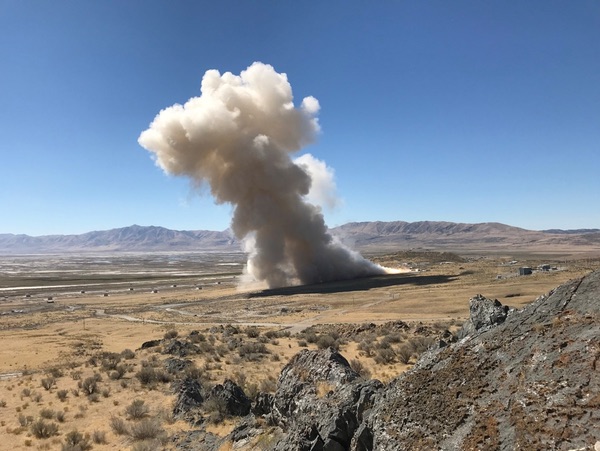Building a better booster (part 1)by Jeffrey L. Smith
|
| While the NGIS team made testing a new motor and winning a highly competitive contract look easy, anyone in the rocket business knows it takes a lot of unseen work to make it look that easy. |
The GEM 63 is a jointly funded effort between NGIS and the US Air Force, and so it’s expected to see airmen and experts from the Aerospace Corporation (the Air Force’s technical experts on rockets) on hand to witness the event. Much less expected though, were representatives from United Launch Alliance (ULA), who will use the GEM 63, and NASA, neither of which were directly paying for the test. Even less surprising was that the event included a soundtrack featuring the greatest hits of The Eagles pumped in through a Jumbotron, and the presence of busloads of schoolchildren and other onlookers who were about to receive the STEM lesson of a lifetime. Such was the apparent confidence of the NGIS team going into a test that they already knew was going to succeed: if they’ve already got the fireworks, why not have a party?
The test went off perfectly, putting on a great show and living up to the confidence the NGIS team had in its success. Less than three weeks later, on October 10, this confidence was mirrored by the Air Force as NGIS was included in the next round of Launch Service Agreements to fund development of the next generation of rockets to launch military satellites. In the long-awaited award, ULA won exactly $967 million, Blue Origin was awarded $500 million on the nose, and NGIS won $791,601,015 (can you tell which of these three submitted their Certified Cost or Pricing Data?) With this win, NGIS will continue development of their own OmegA rocket with a first launch planned for 2021. September’s test was just the first of many as the GEM 63 family of motors is slated to be used on NGIS’s OmegA as well as ULA’s current Atlas V and future Vulcan rockets.
While the NGIS team made testing a new motor and winning a highly competitive contract look easy, anyone in the rocket business knows it takes a lot of unseen work to make it look that easy. Successfully winning a contract is just one important step of many, and does not guarantee a successful outcome. In the past, similarly ambitious programs have sometimes met with disastrous results. The parallels and differences with similar efforts three decades ago provide important insights into how the entire aerospace industry is changing to meet new technical and business challenges.
Fireworks at the GEM 63 test
The GEM 63 program started out of ULA’s need to improve both the performance and the price of its next generation rocket. In order to end the use of Russian engines on its existing Atlas V and to better compete with launch companies like SpaceX, in 2015 ULA announced the Vulcan rocket. Vulcan would take the best parts of Atlas and scale them up for the next generation of larger military and civilian satellites.
At the time, ULA said they would need 20 percent more performance from the solid rocket boosters (SRBs) that attach to side of the rocket, but no decision on a supplier was announced. At that point, ULA was purchasing SRBs from both of America’s premier solid rocket motor manufacturers. Aerojet supplied the AJ-60A for the Lockheed Martin-heritage Atlas V, while Orbital ATK (now NGIS) produced the GEM series for the Boeing-heritage Delta IV rocket. While the first images of Vulcan showed enlarged versions of Aerojet’s SRBs, the race was on to see which of the two companies could meet both ULA’s cost and performance goals and become the sole motor supplier for Vulcan.
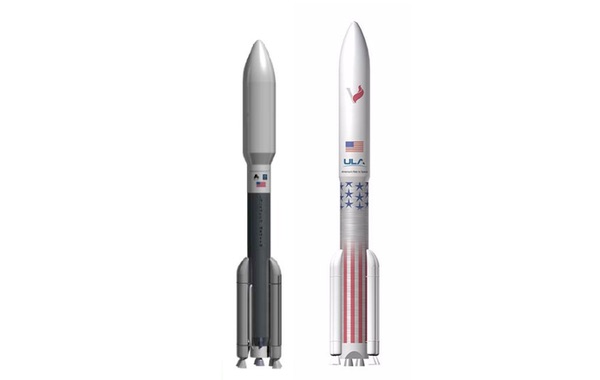 When announced in 2015, initial Vulcan (right) images showed boosters similar to the AJ-60A used on the Atlas V (left). (credit: NASA, ULA) |
Picking the supplier for a critical component of your flagship rocket is a major decision and many factors have to be taken into consideration. While rockets may operate in a vacuum, the rocket industry doesn’t. In 2013, Aerojet had acquired Rocketdyne to form Aerojet Rocketdyne, and the new company was looking for ways to reduce costs and save money. As part of these plans, Aerojet would announce moving their corporate headquarters out of the Sacramento, California, suburb of Rancho Cordova in early 2016 as well as the engineering and manufacturing center there just a year later. Either the factory would have to be kept open longer for a single customer or it would require a complete move and reconstitution of the AJ-60A manufacturing line—both expensive propositions.
| Not only would Orbital ATK promise to make the SRBs for the next generation Vulcan at their existing Utah facilities, but they’d also take on the job of building SRBs for the remaining flights of the Atlas V. |
Rockets are tricky beasts, and moving a rocket factory is both tricky and expensive. Even if you take the exact same machines and set them up in the exact same way, you can never be certain if they will operate precisely as they had before until you’ve actually done it. Will the machines vibrate more or less because the ground they sit on is different? Will the operations be affected by differences in humidity because the weather is different in another part of the country? Will all the key people who know how to correctly build your rocket be willing to relocate their families somewhere else? And finally, how would all these plans affect the Atlas V, which was still scheduled to fly until at least 2022?
With these events unfolding, Orbital ATK was able to make a double pitch: they would produce a family of two brand new motors. Not only would they promise to make the SRBs for the next generation Vulcan at their existing Utah facilities, but they’d also take on the job of building SRBs for the remaining flights of the Atlas V. It is extremely rare for an existing rocket to switch the manufacturer of such a vital component midway through its operational life. On top of that, Orbital ATK promised to fund all of the upfront engineering costs themselves using a combination of internal and Air Force funding and also deliver the new motors at a price some 40 percent lower than the existing AJ-60A, for which ULA charges $5 million. And so in late 2015, ULA selected Orbital ATK to produce all of their future SRBs.
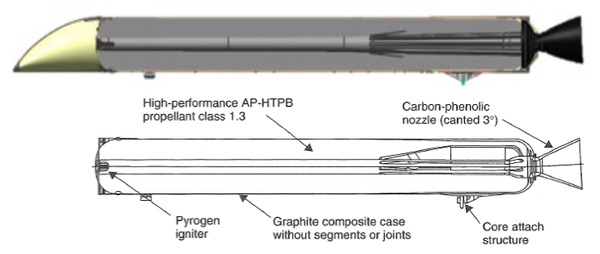 Cross section of the NGIS GEM 63 (above) and the Aerojet AJ-60A (below, with aerodynamic nosecone removed) that it replaces. (credits: above - Northrop Grumman, below - Sutton & Biblarz, 8th ed.) |
The new booster family would come in two versions: the GEM 63 (Graphite-Epoxy Motor case, 63-inch diameter) for the Atlas V and, later, the GEM 63XL (eXtended Length) for the new Vulcan. Both motors have cases made of Hexcel carbon fiber and NGIS’s own proprietary CLRF-100 epoxy resin that have used on other GEM motors. The motors will be thermally insulated with industry-standard EPDM rubber on the inside to protect from the extreme temperature of the rocket’s flame and sheets of cork on the outside to protect from the intense heating that comes from flying many times the speed of sound.
Both motors will be filled with NGIS’s existing QDL propellant recipe, a high-performance HTPB-based mixture already in use on smaller GEM rocket motors. Inside the GEM 63’s 20.1-meter (66-foot) length, the motor will hold 39,700 kilograms (97,500 pounds) of this propellant and burn it up in just 94 seconds to produce a 1,300 psi flame and some 373,000 pounds-force of thrust for the Atlas V. When stretched out to its full 22-meter (72-foot) length, its older sibling the GEM 63XL will burn 48,000 kilograms (105,800 pounds) of propellant to create 454,000 pounds-force of thrust in an even faster 84 seconds!
For those keeping score at home, that’s basically the same size of the Redstone ballistic missile, Wernher von Braun’s first American rocket. And thanks to the fact that today’s rockets are more efficient and solid propellant is so much more dense than liquid propellants, it has a lot more oomph in the same size package. In 1961, Alan Shepard rode a Redstone-sized rocket into space to become America’s first astronaut. Today, that same-sized GEM 63 is now the “small” rocket that is bolted to the side of the much larger Atlas V. And while the Redstone required a government-industry team led by one of history’s greatest rocket scientists and backed by a nation’s defense budget, today, ULA doesn’t bat an eye when NGIS designs and manufactures the same sized rocket in-house at their own expense. American rocketry has come a long way since the early days of Mercury.
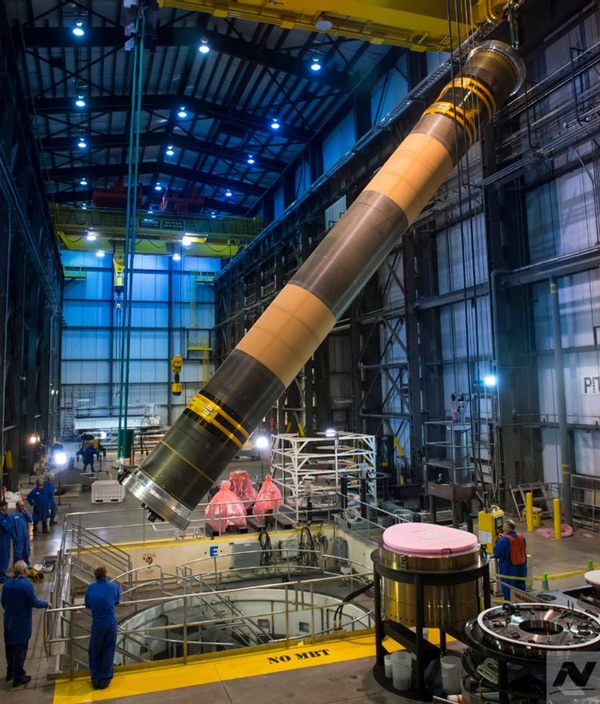 The GEM 63 motor case being lowered into the casting pit before the propellant is poured in. The motor has to be moved in a diagonal position because it’s too tall for the building! (credit: Northrop Grumman) |
Beyond the raw performance of the GEM 63 motors, there were still challenges to overcome. Both the GEM 63 and 63XL were longer motors than anything Orbital ATK had ever made before, or even envisioned making. The existing casting pits, where the propellant is poured into the empty cases, had to be dug an additional 5.5 meters (18 feet) deeper so the motors would fit.
And while you can dig a hole deeper, it’s hard to lift up an existing building. The cast building was never built to handle such long motors, so the overhead crane can’t carry the motor vertically without scraping it along the ground. Clearly that’s a bad idea when it comes to space hardware, so it has to be moved through building diagonally and carefully lowered into the pit in a life-sized version of the game Operation.
| These handcuffs make it hard to introduce something like a new SRB, but in exchange, the aerodynamicists promise to keep the rockets from falling into the ocean. That last part tends to keep the peace. |
NGIS has decades of experience building very high-performance composite cases and these are no different, being designed to operate at a pressure of 1,450 psi. Because rocket engineers are a conservative lot, they actually build the case thicker to hold 40 percent more pressure, some 2,030 psi. And just to be paranoid, before going out the door, each case is filled with water and pressurized to 25 percent above the design pressure (1,813 psi) and checked for leaks. The high internal pressure allows the motor to be fitted with an efficient 14-to-1 expansion ratio nozzle made of carbon phenolic. By comparison, the Space Shuttle’s SRBs operated at just 900 psi and so could only be fitted with a 7.7-to-1 expansion ratio nozzle.
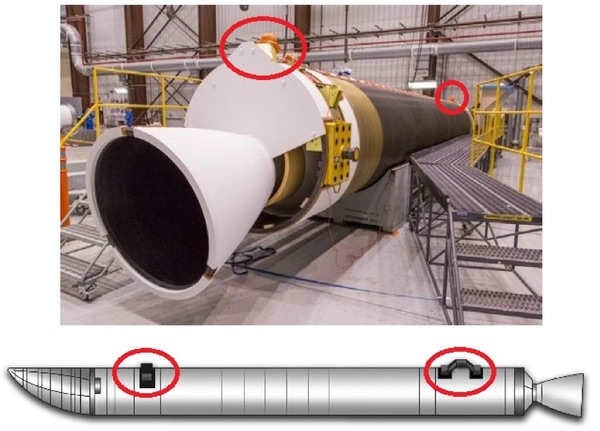 GEM 60 (above) and GEM 63 (below). Previous GEM motors located the rocket attach points at the forward and aft skirt (circled). GEM 63 motors wind the attach points into the composite itself. (credits: NGIS) |
The GEM 63 also required NGIS to learn how to attach SRBs in new ways. Propellant tanks, whether they’re for solid or liquid propellant, are usually connected to each other at the ends, where they can be easily reinforced. This doesn’t particularly impact tanks stacked on top of each other, but does impact rockets when they are attached side-by-side. Unless the liquid propellant tank and SRBs are exactly the same size, one of them has to be built a length that isn’t optimal for overall performance. By developing the ability to put the attachment points mid-body on the composite structure, rocket designers like ULA can optimize their own propellant tanks and then simply tell NGIS where to locate their attach points with no impact to the rest of the vehicle.
The GEM 63 has the requirement to match the AJ60 in terms of fit, form, and function and perfectly replace the existing motor in an already highly optimized system without messing anything up. This is because rocket aerodynamicists are sticklers for telling their chief engineers that they are allowed to modify anything they want inside the rocket, but they can’t change a thing with the rocket’s outer mold line, speed, or weight distribution or else all of their carefully calculated models instantly become worthless. These handcuffs make it hard to introduce something like a new SRB, but in exchange, the aerodynamicists promise to keep the rockets from falling into the ocean. That last part tends to keep the peace.
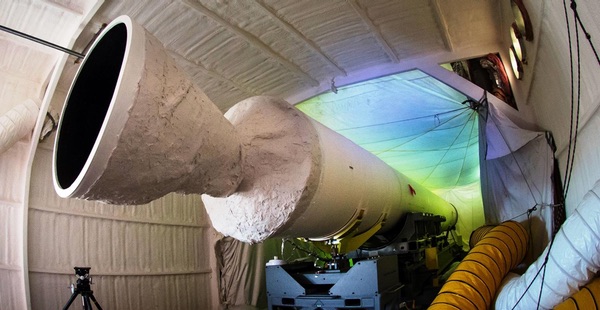 NGIS built a temporary freezer around the GEM 63 test stand. It took a full week to lower the motor’s 100,000 pounds down to 1°C (34°F). (credit: NGIS) |
In order to be a true drop in replacement, the GEM 63 has to match its performance precisely to the AJ-60A. That means the GEM 63’s nozzle is canted (tilted) to the same 3 degrees and it has to operate over the same 4–32°C (40–90°F) range of outside temperatures on launch day. Operating at the very edge of that temperature range was the reason for September’s test. Cold temperatures are always more difficult for solid rocket motors than hot temperatures. Not only does the rubbery propellant become stiffer and more brittle, but the now-cold propellant itself burns slower, like firewood that’s been kept outside during the winter. This slower burning gives extra time for the flame’s heat to penetrate through the insulating rubber and potentially weaken the rocket’s structure underneath. And so, to prove the motor would work properly at and beyond its temperature requirement, NGIS built a massive freezer around the GEM 63 test stand and pumped in freezing air for a week to get the motor down to 1°C (34°F). On test day, after the freezer tent had been removed, the motor had warmed up to 3°C (37°F), but was still under the 40°F requirement.
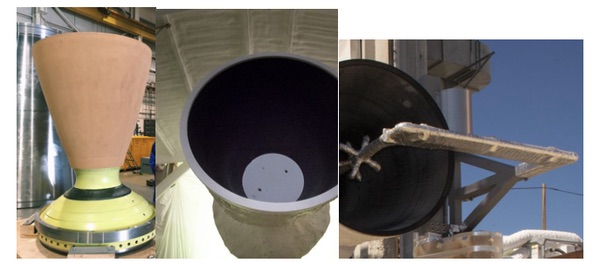 Left to right: GEM 63 aft closure assembly before installation; GEM 63 nozzle before test with throat plug installed; GEM 63 nozzle after firing with water deluge arm - visible tree rings are the plydrops of carbon cloth characteristic of eroding nozzle designs; not shown - jagged throat erosion post firing that is characteristic of eroding throat designs (credits: Northrop Grumman) |
Right on schedule, the motor roared to life as planned. As expected, the normal 94-second burn time was dragged out to an agonizingly long 110 seconds. As the motor’s flames shrank and died down, everyone breathed a sigh of relief, and congratulations were offered to the triumphant team. The water quench arm swung into position behind the motor and drenched the inside of the spent case with water to prevent further smoldering or charring, effectively freezing the motor and its insulation in time at the point of burn out, ready to be dissected and analyzed to see how it performed. Immediately after the test, the Quick Look data even showed the motor had slightly overperformed the initial predictions. If you have to be wrong, you always want to be wrong by having too much performance.
| In aerospace, cost doesn’t scale with size but rather with complexity, and decisions have been taken at every turn to reduce complexity and simplify the design. |
NGIS had just pulled off a minor miracle: they went from contract signing to a full-up firing of a production-representative motor in just three years. That’s a good thing, since the first deliverable motors are due by this June. ULA already has big plans for these motors. The first ones will fly on STP-3 for the Air Force, which has already slipped from the summer to October at the earliest. The Air Force accepts more risk on the Space Test Program (STP) to try out new satellite and rocket technologies. As an example, Falcon Heavy’s first DoD flight is also for STP. This first contract covers 60 total motors with an even 30/30 split between GEM 63s and the larger 63XLs, which ULA has the option to shift if need be. Beyond this first flight, ULA also intends to use the GEM 63 to launch NASA astronauts aboard Boeing’s CST-100 Starliner. These GEM 63 requires no modification to launch astronauts, and ULA will be using uncrewed launches to build up sufficient reliability statistics to prove to themselves and NASA that the new boosters don’t negatively impact crew safety.
The biggest challenge of this effort has been to reduce cost, and the technical decisions reflect this. In aerospace, cost doesn’t scale with size but rather with complexity, and decisions have been taken at every turn to reduce complexity and simplify the design. Instead of a high-priced and complex 3D carbon-carbon throat or a thrust vector control (TVC) system, the GEM 63 features a simple and low-cost carbon phenolic that does not move. This shows a preference for low cost and simplicity over strict performance.
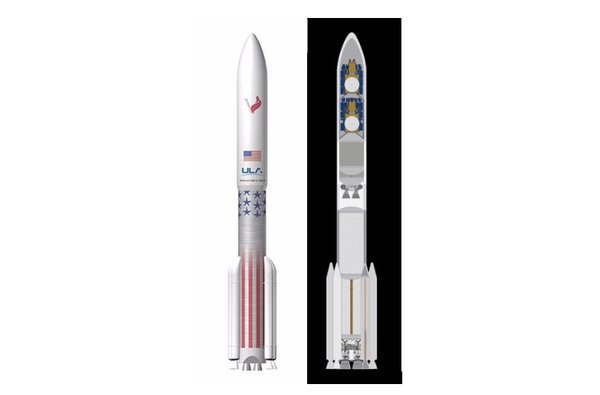 Vulcan when it was originally announced (left) and the design as it exists today (right). (Credit: ULA) |
The Vulcan rocket that will ultimately use the GEM 63XLs has shown a similar preference for design simplicity. ULA got the 20 percent better thrust they were looking for, and by using larger GEM 63XL boosters it allowed ULA to resize their first stage and second stage propellant tanks. As long as you have the thrust to get the whole thing off the launch pad (thank you, GEM 63XL), the decision to increase the size of your gas tank has effectively zero technical risk. Rather than having to add new technology to achieve greater lift capability, they simply fill up the larger tanks. This is a wonderful trade, and one that any rocket scientist would make any day of the week. In addition, the future upgrades can still be implemented down the road, and with the larger gas tanks, it means those upgrades will be even more effective when they are finally introduced. All of this serves to reduce the risk to the current program and increases the likelihood that Vulcan will launch on time.
The US military isn’t the only one counting on the next generation of American launch vehicles. With NASA planning to return to the Moon, there will be a need to send space station modules, cargo, and even landers to lunar orbit and the Moon’s surface itself. While the current crop of EELV-class vehicles has done wonders to build and maintain the International Space Station (ISS), to deliver similar payloads to the vicinity of the Moon larger rockets are needed. In addition to its own Space Launch System (SLS), NASA is already considering the next generation of EELV-class rockets including SpaceX’s Falcon family, Blue Origin’s New Glenn, ULA’s Vulcan, and NGIS’ OmegA. Beyond just the rockets to get there, each company is developing ideas for the space stations and Lunar landers for when they get there.
Note: we are temporarily moderating all comments subcommitted to deal with a surge in spam.
